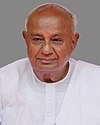United Front (India, 1996)
United Front | |
|---|---|
| Abbreviation | UF |
| Chairman | N. Chandrababu Naidu |
| Founded | 1996 |
| Dissolved | 1998 |
| Preceded by | National Front |
| Headquarters | Andhra Pradesh Bhavan, New Delhi |
The United Front was a coalition government of 13 political parties formed in India after the 1996 general elections.[1] It formed two governments in India between 1996 and 1998. N. Chandrababu Naidu of the Telugu Desam Party served as the convener of United Front.[2][3] The United Front was headquartered at the Andhra Pradesh Bhavan in New Delhi.[4] During its tenure, the government was led by two prime ministers belonging to the Janata Dal – H. D. Deve Gowda and I. K. Gujral

Background
[edit]The Indian general election in 1996 returned a fractured verdict. With the Bharatiya Janata Party emerging as the largest party with 161 of 543 seats, it was invited first to form a government. It accepted the offer, and Atal Bihari Vajpayee was sworn in as the prime minister. However, he was unable to get a majority in parliament, and the government dissolved 13 days later.[5] At a meeting of all the other parties, the Indian National Congress, with a substantial 140 seats, declined to head the government and agreed to extend outside support to the coalition,[6] whereas the Communist Party of India (Marxist) agreed to join the coalition with the Janata Dal at its head,[7] named the United Front.
With the approval of the Congress and CPI(M), the sitting chief minister of Karnataka, H. D. Deve Gowda, was asked to head the coalition as Prime Minister after V. P. Singh and Jyoti Basu declined.[8][9] His term was from 1 June 1996 to 21 April 1997.[10] The Congress revoked its support for Gowda amidst discontent over communication between the coalition and the Congress. It compromised to support a new government under I. K. Gujral, who served as the prime minister from 21 April 1997 to 19 March 1998. Following the collapse of his government, fresh elections were called,[11] and the United Front lost power.[12] Later, when N. Chandrababu Naidu stepped down as convener of the United Front to extend outside support to the National Democratic Alliance, the coalition disbanded.[13]
Electoral performance
[edit]| Year | Legislature | Coalition leader | Seats won | Change in seats | Percentage of votes |
Vote swing | Outcome | Ref. |
|---|---|---|---|---|---|---|---|---|
| 1996 | 11th Lok Sabha | N. Chandrababu Naidu | 305 / 543
|
56.31% | Government | [14] | ||
| 1998 | 12th Lok Sabha | 88 / 543
|
20.98% | Opposition | [15] |
List of prime ministers
[edit]| No. | Portrait | Name | Term in office | Lok Sabha | Cabinet | Constituency | Party | |||
|---|---|---|---|---|---|---|---|---|---|---|
| Start | End | Tenure | ||||||||
| 1 | 
|
H. D. Deve Gowda | 1 June 1996 | 21 April 1997 | 324 days | 11th | Deve Gowda | Rajya Sabha Karnataka |
Janata Dal | |
| 2 | 
|
Inder Kumar Gujral | 21 April 1997 | 19 March 1998 | 332 days | Gujral | Rajya Sabha Bihar | |||
Coalition members
[edit]| Party | 1996 (Post-poll alliance) |
1998 (Pre-poll alliance) |
Seat Change | |
|---|---|---|---|---|
| Internal support | ||||
| Asom Gana Parishad | 5 | 0 | ||
| Communist Party of India | 12 | 9 | ||
| Communist Party of India (Marxist) | 32 | 32 | ||
| Dravida Munnetra Kazhagam | 17 | 6 | ||
| Janata Dal | 46 | 6 | ||
| Samajwadi Party | 17 | 20 | ||
| Tamil Maanila Congress | 20 | 3 | ||
| Telugu Desam Party | 16 | 12 | ||
| External support | ||||
| Indian National Congress | 140 | |||
| Total | 305 | 88 | ||
References
[edit]- ^ M. L. Ahuja (1998). Electoral politics and general elections in India, 1952–1998. Mittal Publications. pp. 9–. ISBN 978-81-7099-711-5. Retrieved 10 December 2010.
- ^ "Chandrababu Naidu: Coalitions have delivered clear policies". The Indian Express. 28 October 2018. Retrieved 12 November 2022.
- ^ Service, Indo-Asian News (20 April 2022). "Andhra Pradesh: Naidu turns 72, gears up for another poll battle". The Siasat Daily. Retrieved 12 November 2022.
- ^ "Routed in many of its strongholds, Third Force loses its pan-Indian identity". India Today. 16 March 1998. Retrieved 29 November 2022.
- ^ "When Atal Bihari Vajpayee Became The Prime Minister For 13 Days And Then 13 Months". India.com. 16 August 2018. Retrieved 26 December 2022.
- ^ "Mamata Banerjee Can Say No UPA Anymore but Her National Goals are Tied to Congress' Future". News18. 3 December 2021. Retrieved 26 December 2022.
- ^ Kumar, Arvind (19 August 2022). "What Left parties' decision to not join Bihar alliance means for India's Dalits, women, MBCs". ThePrint. Retrieved 26 December 2022.
- ^ "Why Jyoti Basu could not be PM". Times of India Blog. 10 January 2010. Retrieved 26 December 2022.
- ^ Mukul, Akshaya. "Historic blunder: How hardliners denied Basu the chance to be PM". The Economic Times. Retrieved 26 December 2022.
- ^ "25 years ago HD Deve Gowda took oath as PM; JDS highlights achievements". www.business-standard.com. Press Trust of India. 1 June 2021. Retrieved 26 December 2022.
- ^ "Elections '98: United Front confident of good performance in coming polls". India Today. 15 December 1997. Retrieved 26 December 2022.
- ^ "Third Front | Alternative political combination and its challenges". Moneycontrol. 11 April 2022. Retrieved 12 November 2022.
- ^ "Chandrababu Naidu 2.0: Can he recreate 1996 in 2019 in the Capital?". Hindustan Times. 10 November 2018. Retrieved 26 December 2022.
- ^ Election Commission 1996.
- ^ Election Commission 1998.
